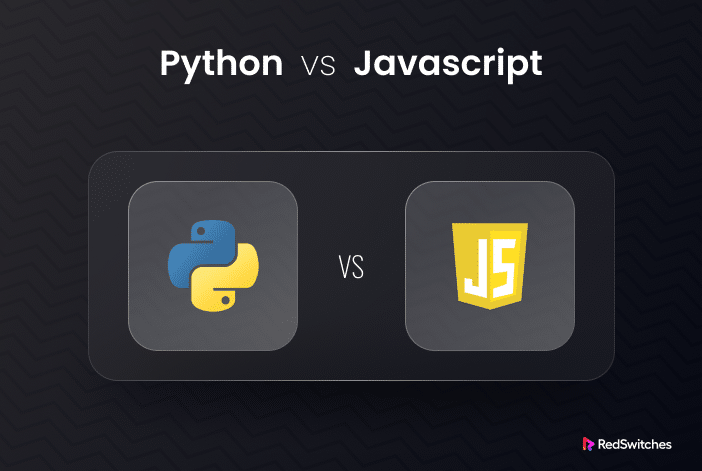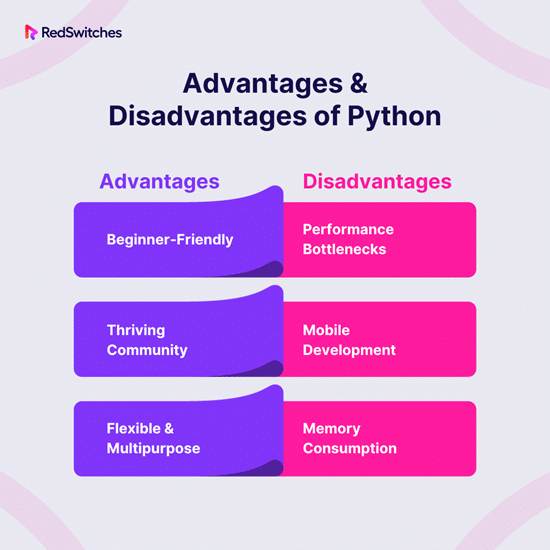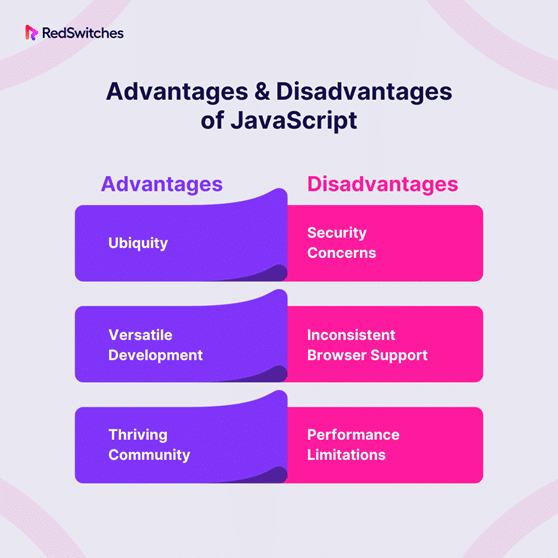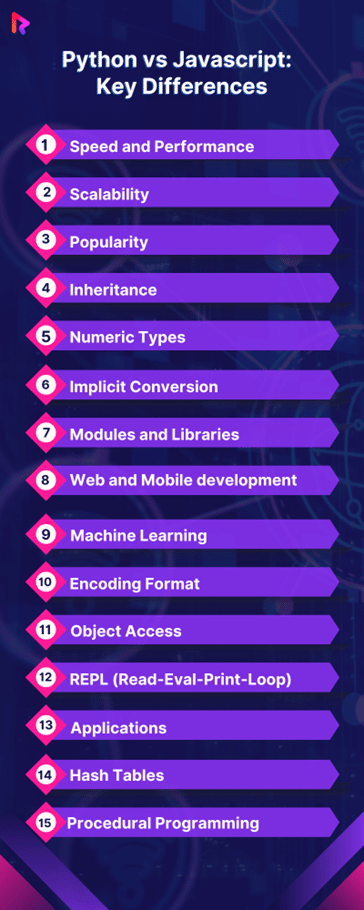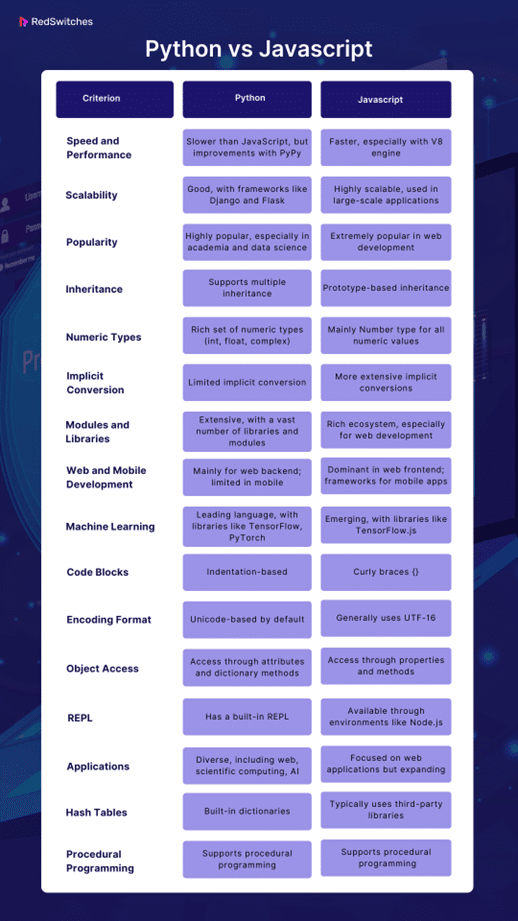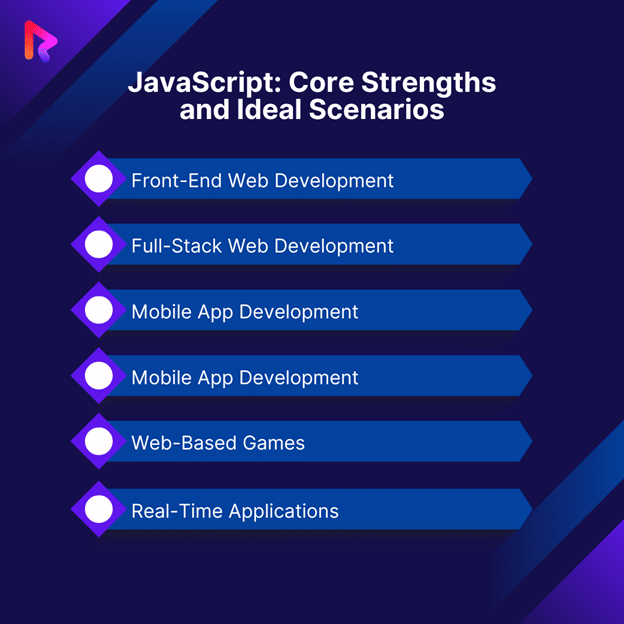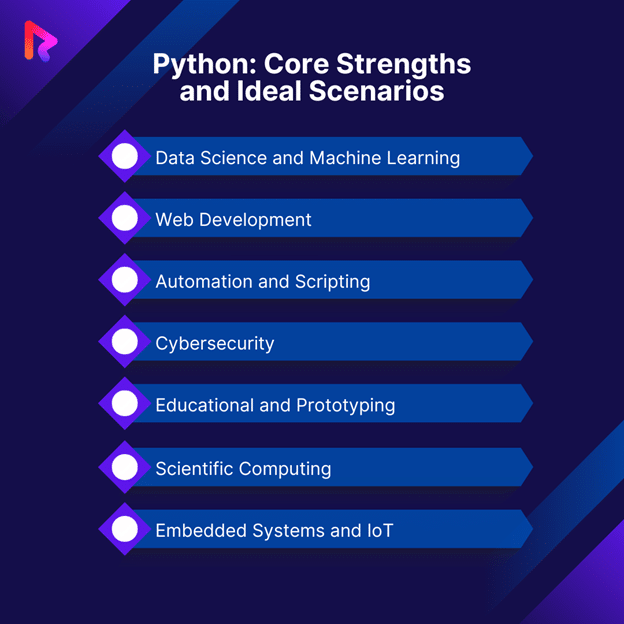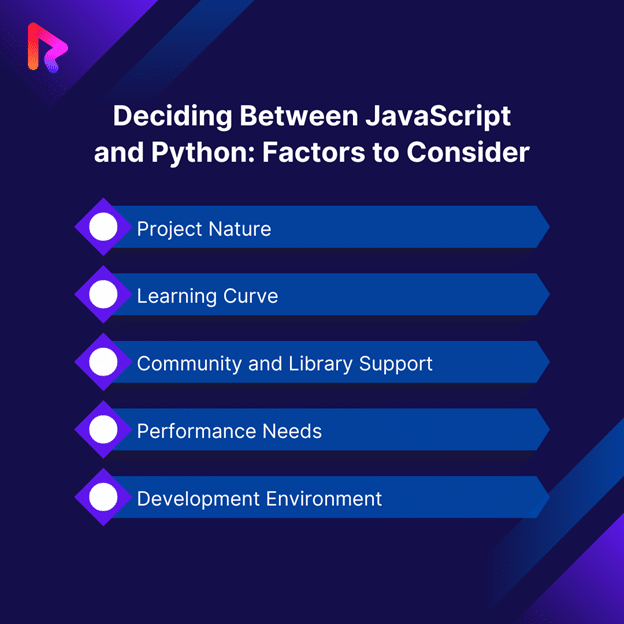As the digital landscape continues to change at breakneck speed, two titans of the programming world have emerged as dominant contenders in the ring: Python and JavaScript. Both languages, each with its robust lineage and fervent community of supporters, have contributed significantly to reshaping how we code, develop, and innovate in the tech realm.
Yet, as 2023 unfolds, the debate rages on which language boasts supremacy and under what conditions. In “Python vs JavaScript Showdown 2023,” we’ll delve deep into 16 pivotal distinctions that every developer, tech enthusiast, and forward-thinker should consider. Whether you’re rooting for Python’s elegant syntax or JavaScript’s web mastery, strap in — it’s time to unravel the intricacies that set these programming powerhouses apart.
Table of Contents
- What is Python?
- What Is JavaScript?
- Python vs Javascript: 16 Key Differences
- When to use JavaScript and when to use Python?
- Deciding Between JavaScript and Python: Factors to Consider
- Conclusion
- FAQs
What is Python?
The allure of the programming realm rests on the shoulders of languages that offer power and elegance. Python, an open-source, high-level programming language, embodies this principle like others.
Originated by Guido van Rossum in the late 1980s, Python is a testament to clarity and functionality. Its broad application spectrum ranges from simple scripting to complex machine-learning algorithms. But what truly makes Python a star in the vast coding universe?
Credit: Unsplash
After exploring the nuances between Python and JavaScript, you might be eager to dive into Python’s ecosystem. If you’re working with Ubuntu, ensure you’re set up correctly by reading our detailed guide on “How to Install Python Pip on Ubuntu 20.04.” Enhance your Python journey with the right tools from the get-go
Key Features of Python
- Readability & Clean Syntax: Python stands out for its uncluttered and English-like syntax. Its emphasis on indentation and whitespace ensures that code is functional and aesthetically pleasing, reducing cognitive load for developers.
- Dynamic Typing: Python’s dynamic nature means developers don’t need to declare variable types explicitly. This offers fluidity in the coding process but requires carefulness to avoid type-related errors.
- Interpreted Language: Python doesn’t need a compiler to convert code into machine instructions. The Python interpreter processes code line-by-line, which can be a boon for debugging but may sometimes slow down execution.
- Extensive Libraries & Frameworks: Whether you’re delving into natural language processing, image recognition, or web application development, Python has a library or framework ready to aid your endeavor.
- Cross-Platform Compatibility: Write once, run anywhere! Python’s platform-agnostic nature ensures minimal friction when shifting between different operating environments.
Use of Python
- Web Development: Using frameworks like Django, Flask, or Pyramid, developers can swiftly bring to life robust and scalable web applications.
- Data Science & Machine Learning: Python reigns supreme in data manipulation, statistical analysis, and machine learning. Tools like Pandas, NumPy, and TensorFlow are often the first choice of data scientists worldwide.
- Automation & Scripting: Python’s scripting capabilities are unparalleled, whether you’re automating mundane tasks, crawling web pages, or setting up automated testing.
- Game Development: While not its most popular use-case, Python has still made a mark in game development with libraries such as Pygame.
- Embedded & IoT Systems: Python’s compactness and scalability have made it suitable for Internet of Things (IoT) devices and embedded system applications.
Advantages & Disadvantages of Python
Advantages:
- Beginner-Friendly: Its intuitive syntax and structure make Python an excellent starting point for budding developers.
- Thriving Community: Python’s massive community means developers can easily find solutions, share knowledge, and access many libraries and tools.
- Flexible & Multipurpose: Python’s versatility, from building web servers to AI models, is hard to match.
Disadvantages:
- Performance Bottlenecks: As an interpreted language, Python can face challenges in delivering performance at par with languages like C or Java.
- Mobile Development: Python lags in the mobile application development sector. Frameworks exist but are not as robust as those for languages like Swift or Java.
- Memory Consumption: Python’s dynamism makes it memory-intensive, which can be a limitation for applications where memory efficiency is crucial.
Understanding the essentials of Python’s environment can be pivotal as you navigate the complexities of Python and JavaScript. Don’t miss out on our detailed guide, “How to Check Python Version in Linux, Windows, And macOS: A Comprehensive Guide.” Ensuring you use the right Python version can save you from pitfalls.
What Is JavaScript?
Few have garnered as much attention, adoption, and discussion as JavaScript in the vast arena of programming languages. Initially conceived in the mid-90s by Brendan Eich while at Netscape, JavaScript was devised to make web pages dynamic and interactive.
Credit: Freepik
Over the years, its capabilities have transcended its original intent, shaping it into a full-fledged programming language suitable for client- and server-side development. But what elevates JavaScript above its counterparts in the crowded tech realm?
Key Features of JavaScript
- Event-Driven: JavaScript operates on an event-driven model, meaning it waits and listens for events like clicks or key presses, making web interactivity possible.
- Object-oriented: While not purely object-oriented, JavaScript supports object-oriented programming principles using prototypes.
- Interpreted Language: Like Python, JavaScript is interpreted. Web browsers read and execute JavaScript code line-by-line without requiring a compiler.
- Asynchronous Capabilities: With features like AJAX, Promises, and async/await, JavaScript can perform non-blocking operations, enhancing the responsiveness of web applications.
- First-Class Functions: Functions in JavaScript are first-class objects. They can be given to variables, passed as arguments, and returned from other functions.
If you’re on Ubuntu 22.04 and wish to experiment with or adopt Node.js, don’t miss our guide on “Three Simple Ways You Can Install Node.js On Ubuntu 22.04.” Equip yourself with the know-how to seamlessly integrate JavaScript’s runtime into your development environment.
Use of JavaScript
- Web Development: Originally designed for the web, JavaScript remains at the heart of web development, enabling dynamic and interactive web pages.
- Server-Side Development: With the advent of Node.js, JavaScript has surged into the backend, powering servers and handling databases.
- Mobile App Development: Platforms like Ionic and React Native allow developers to craft high-quality mobile apps using JavaScript.
- Game Development: While not as dominant as other platforms, JavaScript, combined with WebGL, can be employed to develop browser-based games.
- Desktop Applications: Tools like Electron facilitate the creation of cross-platform desktop applications with JavaScript.
Advantages & Disadvantages of JavaScript
Advantages:
- Ubiquity: Almost all modern web browsers support JavaScript. Its universal acceptance ensures web pages remain interactive across different devices and platforms.
- Versatile Development: JavaScript’s vast ecosystem ensures it fits almost every development facet from frontend to backend to mobile.
- Thriving Community: The JavaScript community is vast and active. This guarantees many resources, libraries, and tools available to developers.
Disadvantages:
- Security Concerns: Being client-side, JavaScript is exposed to the end user, making it susceptible to malicious manipulations.
- Inconsistent Browser Support: While the situation has improved, discrepancies in how browsers interpret JavaScript can lead to inconsistent user experiences.
- Performance Limitations: Though faster than before, intensive computational tasks in JavaScript can still lag behind other languages, especially when executed on the browser.
Deciphering JavaScript in its fullness unveils a language that has evolved from mere web scripting to a versatile tool for various development needs. Its juxtaposition with Python thus becomes a captivating exploration, bringing to light the strengths and intricacies of each in a world dominated by digital innovation.
Python vs Javascript: 16 Key Differences
In the grand amphitheater of technology, few debates resonate as loudly as the one between Python vs JavaScript. These two behemoths, having carved out niches of excellence in their respective domains, often find themselves pitted against each other in discussions spanning from classrooms to corporate boardrooms.
However, rather than seeing them as adversaries, a discerning eye would identify the unique strengths, philosophies, and applications that define each. In this exploration, we will journey through 16 key differences illuminating the distinctiveness of Python vs JavaScript. Whether you’re an aspiring coder determining which language to learn first or a seasoned developer aiming to diversify your skills, this comparative analysis promises insights that will refine your perspective and guide your decisions.
Speed and Performance
In the relentless pursuit of optimal software performance, developers often weigh the benefits and cons of various languages. Regarding Python vs JavaScript, the debate on speed and performance is particularly heated. Heralded for their unique strengths and wide-ranging applications, both languages have distinct advantages and limitations.
Execution Process: Compiled vs Interpreted
JavaScript:
- Compiled Nature: Contrary to popular belief, modern JavaScript engines, like V8 (used in Chrome and Node.js), don’t merely interpret the language. They employ Just-In-Time (JIT) compilation, converting the code into machine code just before execution. This contributes to its speed.
Python:
- Interpreted Nature: Python is quintessentially interpreted. This means the Python interpreter reads and executes the code line-by-line, often leading to slower execution when compared to compiled languages.
Concurrency: Single-Threaded vs Multi-Threaded
JavaScript:
- Single-Threaded Paradigm: While JavaScript operates on a single-threaded event loop model, assuming it cannot handle concurrent tasks is misleading. JavaScript efficiently manages asynchronous operations with its non-blocking nature and features like async/await and Promises.
Python:
- Multi-Threaded Nature: Python, inherently multi-threaded, uses the Global Interpreter Lock (GIL), which means only a single thread is executed at a time in a single process. This sometimes hinders performance in CPU-bound tasks, contrary to the assumption that multi-threading always speeds things up.
Task Suitability and Libraries
Python:
- CPU-Intensive Tasks: Regarding scientific computing, data analysis, or machine learning, Python often has the edge. Libraries like NumPy, TensorFlow, and Scikit-learn are highly optimized for such tasks, making Python faster in these specific scenarios.
JavaScript:
- Web-Based Tasks: JavaScript is inherently faster for tasks closely associated with web browsers and rendering. Its event-driven architecture ensures responsiveness and swift execution.
Other Influencing Factors
- Hardware Dependency: The performance of both Python and JavaScript is tethered to the hardware they run on. A robust CPU and ample RAM can significantly uplift the execution speed.
- Code Quality: Regardless of whether one is using Python or JavaScript, the elegance, efficiency, and quality of the written code profoundly influence performance.
- Library Efficiency: The external libraries and frameworks integrated into the development process play a crucial role. While some are optimized for speed, others prioritize functionality or flexibility.
While the discourse on Python vs JavaScript in terms of speed and performance can often skew towards JavaScript’s superior speed in many contexts, it’s paramount to understand that the ‘best’ language isn’t solely about speed. Factors such as development environment, project requirements, ease of learning, code readability, and maintainability also hold immense weight when choosing between Python and JavaScript.
Scalability
As modern applications continue to cater to a vast global user base, scalability emerges as a paramount criterion in choosing the correct programming language. Understanding the intrinsic and extrinsic factors influencing scalability becomes critical in the Python vs JavaScript debate. With their distinctive design philosophies and ecosystems, both languages offer unique scalability solutions.
Concurrent Request Handling
JavaScript:
- Single-Threaded Advantage: JavaScript’s single-threaded model, contrary to initial perceptions, serves as a boon for handling concurrent requests, mainly when used with event-driven architectures.
Python:
- Multi-Threaded Challenges: Being multi-threaded, Python, by default, can face challenges in concurrent request handling, primarily due to the Global Interpreter Lock (GIL).
Server-Side Solutions
JavaScript:
- Node.js: Pairing JavaScript with Node.js enhances its scalability profile. Node.js, recognized for its non-blocking I/O and event-driven architecture, has become a natural choice for high-traffic web applications.
Python:
- Multiprocessing: One of Python’s remedies for scalability concerns is its multiprocessing library. It offers a potential boost in handling concurrent requests by enabling multiple processes to run simultaneously.
- load balancers: To further the difference between Python and JavaScript, Python often leans on external solutions, like load balancers, to distribute incoming requests across servers, augmenting scalability and reliability.
Architecture, Database, and Other Considerations
- Application Architecture: The underlying architecture is pivotal in scalability. Microservices, for instance, are generally more scalable than monolithic architectures.
- Database Choices: The scalability conversation extends to databases. Due to their distributed nature, NoSQL databases often outpace relational databases in scalability for specific application types.
- Caching Mechanisms: Python and JavaScript benefit from caching solutions that bolster application responsiveness and scalability by minimizing database calls.
- Deployment Environments: Whether it’s cloud-based or on-premises, the deployment environment can make a profound difference in the scalability of an application.
In the overarching discourse of Python vs JavaScript, while JavaScript, especially with Node.js, often receives accolades for its inherent scalability, Python, with its vast ecosystem, offers myriad ways to scale efficiently. But it’s imperative to remember that scalability is one facet of the multifaceted gem called software development. Ease of use, code readability, maintainability, and community support are just as vital when weighing the difference between Python and JavaScript.
Popularity
In dynamic programming, trends evolve, new languages emerge, and some diminish into obsolescence. However, amidst this flux, the popularity contest featuring Python vs JavaScript consistently garners attention. These two languages, leaders in their domains, have stood the test of time and continue to grow and adapt to contemporary challenges.
Popularity Metrics and Indications
Python:
- Website Usage: Python powers 1.4% of websites for which the server-side programming language is identified.
- Growth Trajectory: Although it might seem to have a lesser market share in the web domain than JavaScript, Python’s growth rate, particularly in diverse domains, is astounding.
- PYPL Index: According to the PYPL Popularity of Programming Language index, Python proudly clinches the top spot, indicating its dominance in the developer community.
Credit: Freepik
JavaScript:
- Website Usage: JavaScript, the reigning champion of the web, is used by 4.7% of all known websites. When considering high-traffic websites (top 1,000,000), this figure further elevates to 5.4%.
- PYPL Index: JavaScript closely trails Python, cementing its position as a top-tier language in the index.
Application and Strengths
Python:
- Versatility: Python’s allure stems from its broad application spectrum, from machine learning and data science to web development.
- Readability: Heralded for its concise and human-readable syntax, Python appeals to beginners and seasoned developers alike.
JavaScript:
- Web Dominance: Primarily recognized as a front-end language, JavaScript’s prowess in creating dynamic web interfaces is unmatched. Moreover, with Node.js, it has successfully ventured into the back-end realm.
- Performance: With its speedy execution and non-blocking I/O operations, JavaScript is lauded for its performance-centric design.
Catalysts for Popularity
- General-Purpose Nature: The debate of Python vs JavaScript, which is better, often converges on their general-purpose nature, enabling both languages to cater to diverse applications, from gaming to scientific computing.
- Ease of Learning: Python’s intuitive syntax and JavaScript’s ubiquitous presence on the web make them front-runners for programming enthusiasts and novices.
- Thriving Communities: Both languages boast robust communities, ensuring abundant resources, tutorials, forums, and open-source contributions.
In the persistent tug of war of Python vs JavaScript, which is better, it’s pivotal to acknowledge that ‘better’ is subjective. Your project requirements, long-term goals, and personal inclinations play a role in this choice. Both languages, riding on their strengths, offer a comprehensive ecosystem to build and deploy many applications. The decision thus hinges on context rather than a definitive superior.
Inheritance
In object-oriented programming (OOP), inheritance is a foundational pillar, allowing for the creation of a new class derived from an existing one. Inheritance fosters code reuse and establishes relationships between the base (or superclass) and derived (or subclass) entities. When juxtaposing Python vs JavaScript in the context of inheritance, it’s evident that while the concept remains consistent, the implementation and nuances diverge.
Python’s Approach to Inheritance
Class-Based Inheritance:
- Python, inherently an object-oriented language, employs a traditional class-based approach to inheritance.
- Subclasses can inherit attributes and methods from a superclass, enabling code reusability and establishing a clear hierarchy.
Syntax:
- Python uses a straightforward syntax for inheritance. For instance, class DerivedClass(BaseClass): would denote that DerivedClass is inheriting from BaseClass.
Multiple Inheritance:
- One of the distinguishing facets of Python is its support for multiple inheritance, where a class can inherit from multiple superclasses.
Method Overriding:
- If a method in the derived class has the same name as the base class, Python will precede the method in the derived class, showcasing method overriding.
JavaScript’s Approach to Inheritance
Prototype-Based Inheritance:
- JavaScript diverges from the classical inheritance model, embracing prototype-based inheritance instead.
- Every object in JavaScript has an internal link (or prototype) to another object. When a property is accessed, JavaScript traverses the prototype chain until the property is found or the end of the chain is reached.
Syntax:
- Traditional JavaScript utilized functions and the prototype property to facilitate inheritance. Modern ES6+ JavaScript introduced the class syntax, making inheritance more intuitive, but the underlying mechanism remains prototype-based.
Single Inheritance:
- In line with its prototype chaining, JavaScript supports single inheritance. An object can have one prototype link pointing to another object.
Method Overriding:
- Like Python, JavaScript allows method overriding by defining a method in the derived object with the same name as in the prototype.
Key Differences and Considerations
- Philosophy: While both languages embrace OOP, Python leans towards a classical, class-based system, while JavaScript adopts a more flexible, prototype-based model.
- Flexibility vs. Formality: JavaScript’s prototype-based inheritance grants dynamic capabilities, like adding properties or methods to existing objects at runtime. In contrast, Python’s structured approach emphasizes formal class definitions.
- Performance: In specific scenarios, JavaScript’s prototype lookups might be marginally slower than Python’s direct class-based access, but this largely depends on the code’s structure and the prototype chain’s depth.
In the Python vs JavaScript inheritance discourse, the choice between them doesn’t hinge solely on their inheritance model but on broader project requirements, familiarity with the languages, and the specific application domain. Both languages offer robust solutions to implement and leverage inheritance, each with its flavor and idiosyncrasies.
Numeric Types
In programming, how languages handle numeric values is vital. We’ll discover each language’s unique aspects and capabilities as we compare Python vs JavaScript in numeric types.
Diving Into Python’s Numeric World
Python, known for its versatility, offers different types to deal with numbers:
Integers (int)
- Represent whole numbers, both positive and negative.
- There’s essentially no size limit to integers in Python.
Floating-Point Numbers (float)
- Deals with decimal numbers.
- Can capture fine details up to 15 decimal places.
Complex Numbers (complex)
- Made for numbers with real and imaginary components.
- Ideal for certain mathematical and scientific computations.
Unraveling JavaScript’s Numeric Spectrum
JavaScript’s numeric framework is streamlined yet effective:
General Numbers (Number)
- A versatile type that handles whole numbers and decimals.
- However, there’s a cap on the size of the integers.
Arbitrarily Large Integers (BigInt)
- Specialized for huge numbers beyond the regular Number type’s capacity.
Python vs JavaScript: A Comparative Glance
Variety of Numeric Types:
- Python: Offers a richer variety with int, float, and complex.
- JavaScript: Mainly revolves around the Number and BigInt types.
Precision:
- Python: Floats in Python allow up to 15 decimal places, offering higher precision.
- JavaScript: While precise, the Number type might not always match Python’s float in capturing extremely fine details.
Handling Massive Numbers:
- Python: With the int type, Python can handle incredibly large numbers without a hiccup.
- JavaScript: For extremely large numbers, developers would switch to BigInt.
In conclusion, both languages bring their strengths when evaluating Python vs JavaScript based on numeric types.
Implicit Conversion
In the coding realm, implicit conversion or type coercion is the automatic transformation of one data type into another. While this can simplify code by removing the need for explicit type conversions, it might also lead to unexpected outcomes if not managed properly. In the Python vs JavaScript debate, how each language handles implicit conversion reveals distinct approaches and philosophies.
Credit: Freepik
The Python Paradigm
Python’s approach to implicit conversion can be summarized as cautious. The language prefers clarity over potential ambiguity.
Strictness:
- Python usually doesn’t convert different numeric types implicitly. For instance, adding an integer to a string without explicit conversion results in a TypeError.
Explicitness Over Implicitness:
- A fundamental philosophy of Python, which generally avoids operations that can cause confusion.
- Explicit type conversion is often required to perform operations between incompatible data types.
Common Automatic Conversions:
- Integers and floats are compatible with arithmetic operations. Python will implicitly change the integer to a float to perform the operation if you try to add an integer to a float.
Navigating JavaScript’s Waters
Contrastingly, JavaScript is quite liberal with implicit conversions, which is handy but can be a double-edged sword.
Frequent Coercion:
- JavaScript tries to make sense of an operation even if the operands differ. For example, adding a number to a string would concatenate the two.
Truthiness and Falsiness:
- JavaScript has a broader concept of what’s true or false. Non-boolean values can be coerced into a boolean context, resulting in unexpected truth or false evaluations.
Challenges:
- The flexibility can lead to unexpected results, especially for developers of stricter typed languages.
- A classic pitfall is the “2” + 2 operation, which results in the string “22” rather than the number 4.
Python vs JavaScript: Key Differences in Implicit Conversion
Philosophy:
- Python: Advocates for explicitness, minimizing surprises but requiring more manual intervention.
- JavaScript: Prioritizes ease of use and flexibility, which can introduce unexpected results.
Error Handling:
- Python: More likely to raise errors when encountering potentially ambiguous operations.
- JavaScript: Attempts to coerce types and carry out operations can sometimes lead to non-intuitive outcomes.
Type Handling:
- Python: Clear and strict boundaries between data types.
- JavaScript: Fluid transitions between types, especially in arithmetic and logical operations.
In summation, while the debate on Python vs JavaScript is vast, implicit conversion showcases a fundamental difference in their design philosophies. Whether you prefer Python’s clarity or JavaScript’s adaptability depends on your project needs and personal coding style. However, understanding how each language handles type coercion is crucial to avoiding pitfalls and writing robust code.
While exploring the nuances of Python vs JavaScript, delving deeper into Python’s intricacies can offer fresh perspectives. Check out our comprehensive guide on “How to Find the Length of a List in Python: Three Easy Methods and Tips.” This article will help you grasp one of Python’s fundamental operations. Whether you’re weighing the strengths of both languages or honing your Python abilities, this piece is a must-read.
Modules and Libraries
Python and JavaScript stand out in the programming world with their expansive ecosystems, aiding developers with many modules and libraries. However, when examining Python vs JavaScript in the context of their ecosystems, particular distinctions emerge.
Python’s Expansive Ecosystem
Python’s reputation for its vast standard library is well-deserved, encompassing numerous tasks immediately.
Standard Library:
- Python’s built-in library caters to tasks ranging from web development to machine learning.
Community Contributions:
- The Python Package Index (PyPI) is the hub for third-party Python libraries, a testament to the dynamic Python community.
System-level Installation:
- A significant feature of Python modules is that they’re typically system-wide, allowing for reuse across different projects.
Typically Pythonic:
- Python libraries and modules are, for the most part, written in Python, ensuring language consistency.
Examples of Python Libraries:
- NumPy: Scientific computing.
- Pandas: Data manipulation.
- Matplotlib: Visualization.
- TensorFlow: Machine learning.
- Django & Flask: Web development.
JavaScript’s Diverse Ecosystem
While JavaScript might not have a standard library as extensive as Python’s, its modular ecosystem is nevertheless formidable.
Basics of the Standard Library:
- JavaScript’s built-in library predominantly caters to DOM manipulation and networking tasks.
Vibrant Community Libraries:
- npm (Node Package Manager) is the go-to repository for many third-party JavaScript libraries.
Project-level Installation:
- Contrasting Python, JavaScript leans towards project-specific module installations, offering granular control over dependencies.
Diverse Language Options:
- Libraries in the JavaScript ecosystem can be authored in JavaScript, TypeScript, or other languages, providing flexibility.
Examples of JavaScript Libraries:
- React, Vue.js, & Angular: Front-end development.
- Node.js & Express: Backend development.
- MongoDB: NoSQL database tasks.
Python vs JavaScript: Making the Choice
The battle of Python vs JavaScript for modules and libraries boils down to specific project requirements:
Opt for Python if:
- A comprehensive standard library is desired.
- System-wide module installations are preferred.
Consider JavaScript if:
- Project-specific dependencies are more in line with your requirements.
- You seek flexibility in the language of the libraries.
Regardless of the choice, both languages promise rich ecosystems, ensuring developers are well-equipped to tackle various challenges.
Web and Mobile development
Both Python and JavaScript have established themselves as giants in web and mobile development. Each has unique offerings, making the Python vs JavaScript debate interesting for developers.
Python in Web and Mobile Development
Python, acclaimed for its easy-to-read syntax, finds utility in data science, machine learning, and web development.
Versatility:
- Python is a general-purpose language revered for its simplicity and ease of understanding.
Web Development:
- Frameworks: Python’s arsenal includes frameworks like Django, Flask, and Pyramid, simplifying web application development.
Mobile Development:
- While not the leading choice for mobile development, Python offers frameworks like Kivy and BeeWare.
- It’s worth noting that Python’s popularity in mobile development is relatively moderate compared to JavaScript.
JavaScript in Web and Mobile Development
Primarily recognized as a front-end web language, JavaScript’s capabilities extend to back-end development with technologies like Node.js.
Performance:
- JavaScript is notable for its swiftness and efficient execution, especially in browser contexts.
Web Development:
- Frameworks: JavaScript’s ecosystem boasts frameworks such as React, Vue.js, and Angular, catering to diverse web application needs.
Mobile Development:
- JavaScript shines with frameworks like React Native and Flutter, allowing the development of native mobile applications using JavaScript.
Python vs JavaScript: The Verdict
The question of “which is better” in the Python vs JavaScript dichotomy is contingent upon individual objectives:
Python’s Strengths:
- Ease of learning and readability.
- Strong presence in web development, with some footing in mobile application development.
JavaScript’s Strengths:
- Speed and a vast array of web and mobile development frameworks.
- Preeminent in both web and mobile landscapes.
Both Python and JavaScript are formidable web and mobile development contenders. Your specific project requirements, goals, and personal preferences should dictate your choice.
Credit: Freepik
Machine Learning
Machine learning continues to grow and diversify, with Python vs JavaScript becoming significant players. Each offers unique advantages for different aspects of machine learning. Let’s unravel their strengths and potential applications.
Python in Machine Learning
Renowned for its clean syntax and versatility, it is a machine learning frontrunner.
Nature of the Language:
- Python is a general-purpose language, versatile enough to cater to beginners and seasoned developers.
Resource-Rich Ecosystem:
- Python boasts an expansive arsenal of machine learning libraries such as NumPy, Pandas, Scikit-learn, and TensorFlow. These tools empower developers to build, test, and refine their machine-learning models more efficiently.
Prototyping & Experimentation:
- Python’s interactive nature facilitates rapid prototyping and algorithm experimentation, making it a preferred choice for research and development.
JavaScript in Machine Learning
While JavaScript is traditionally a front-end web development language, its potential in the machine learning space, especially in deployment, is becoming increasingly evident.
Language Characteristics:
- JavaScript’s forte lies in its speedy execution and performance, not forgetting its prowess in back-end development via Node.js.
Growing Machine Learning Libraries:
- Although not as extensive as Python’s, JavaScript’s machine learning library suite is growing. Notable mentions include TensorFlow.js, Brain.js, and Kubeflow.js.
Deployment & Integration:
- JavaScript excels in deploying machine learning models. Its compatibility with web browsers and mobile platforms makes it a go-to for real-time applications and integrations.
The Verdict in Machine Learning:
Python’s Strongholds:
- With its comprehensive library support, Python is preferred for in-depth research, learning, and model prototyping.
- Its expansive community also means ample support and resources for newcomers and experts.
JavaScript’s Domain:
- JavaScript shines if real-time deployment, integration, or web-based applications are the targets.
- Its efficiency in executing tasks, especially in web environments, is a considerable strength.
In summation, while both Python and JavaScript offer formidable capabilities in the machine learning realm, your choice should align with the project’s specific demands. Embracing both can indeed provide a holistic approach to modern machine learning challenges.
Code Blocks
Python and JavaScript are powerful programming languages, each with a unique approach to defining code blocks. Here’s a detailed comparison:
Python’s Approach to Code Blocks
Indentation-Driven:
- Python distinctly uses indentation to define code blocks, implying a code’s hierarchical structure and the logical flow of the program.
def my_function():
"""This is a simple function."""
print("Hello, world!")
Pros:
- Enhances code readability, creating a visually cohesive structure.
- Eliminates the need for extra characters like braces.
Cons:
- Mistakes in indentation can easily lead to syntax errors.
- New users might find it initially confusing as indentation levels need to be consistent.
JavaScript’s Approach to Code Blocks
Curly Braces:
- JavaScript employs curly braces { } to encapsulate code blocks, demarcating the beginning and end of a function, loop, or condition.
function myFunction() {
// This is a simple function.
console.log("Hello, world!");
}
Pros:
- Explicit start and end points, reducing ambiguity.
- A common practice in many C-style languages, making it familiar to many developers.
Cons:
- This can result in “brace clutter,” especially with nested blocks.
- Indentation inside the braces is purely stylistic, which can lead to inconsistent code styling if not enforced.
Which Is Better?
The preference for code block definition truly boils down to individual tastes and the problem:
- Python offers a neat, minimalistic look but demands precision in indentation.
- JavaScript, while a tad more verbose with its braces, offers a universally familiar structure in many other languages.
Both methods have merits, and neither is objectively superior. Choosing between Python vs Javascript often relies on the project’s nature, the team’s familiarity with the language, or specific use-case requirements.
While diving deep into the contrasts between Python and JavaScript, it’s essential not to overlook other significant language comparisons. Explore our comprehensive analysis in “Python vs PHP: How To Choose The Best Language For Your Projects?“. Gaining a broader perspective on where Python stands against PHP can provide a more holistic view of making the right choice for your next project.
Encoding Format
Python and JavaScript handle textual data differently by default due to their encoding schemes. These encodings are essential for determining how computer systems store and read textual data.
Python’s Default Encoding: ASCII
Nature:
- ASCII is essentially a 7-bit character encoding standard.
- It can represent 128 distinct characters.
- Primarily accommodates the English alphabet, numbers, and some special characters.
Pros:
- Simplicity: ASCII is straightforward and concise.
- Compatibility: Older systems predominantly used ASCII.
Cons:
- Limited Range: Can’t represent characters beyond its set, making it unsuitable for many non-English languages or special symbols.
- Potential Misinterpretation: Non-ASCII characters in an ASCII-encoded file may not render correctly on some systems.
Note: Modern Python versions often default to UTF-8, a more inclusive encoding scheme. You can explicitly specify the encoding using a comment like #coding:utf-8 in Python scripts.
JavaScript’s Default Encoding: UTF-16
Nature:
- UTF-16 uses 16-bit units to encode characters.
- It covers many characters, well over a million, accommodating numerous languages and symbols.
Pros:
- Versatility: Can represent many languages, making it suitable for international applications.
- Modern Standard: Many current systems and applications are optimized for UTF-16 or similar Unicode encodings.
Cons:
- Larger Memory Footprint: May use more storage space for primarily ASCII characters than ASCII encoding would. or JavaScript React for UI, the vast array of tools amplifies their capabilities.
- Potential Compatibility Issues: Some older systems or applications may not support UTF-16 correctly.
Which Encoding Should You Choose?
It’s not so much a matter of one language being “better” than another regarding encoding but more about the specific requirements of your project:
- Multilingual Support: If your application targets a global audience with multiple languages, UTF-16 (JavaScript) might be more suitable.
- Legacy Systems: If you’re interacting with older systems or databases, they might prefer ASCII or another older encoding, making Python’s default a potential fit.
- Flexibility: Python and JavaScript allow you to change the default encoding as needed, so you can select an encoding that matches your project’s needs.
Remember, understanding your application’s context and the audience will guide you in making the right encoding decision between Python vs Javascript.
Object Access
When diving into the realm of programming, understanding how different languages handle data structures is fundamental. Among the nuances, the method by which we access object properties stands out, especially when contrasting languages like Python and JavaScript. Both are titans in their respective domains, yet they offer distinct syntaxes and methodologies for this task. Let’s explore how each approaches the world of object property access.
Credit: Freepik
Python’s Object Access
In Python, attributes or properties of an object, particularly for dictionaries, are accessed using the key in square brackets. Additionally, for objects of classes, the attributes are accessed using dot notation.
Example:
# For dictionaries
my_object = {
"name": "Alice",
"age": 25
}
print(my_object["name"])
# For class objects
class Person:
def __init__(self, name, age):
self.name = name
self.age = age
person = Person("Alice", 25)
print(person.name)
Pros:
- Straightforward for dictionary access with the square bracket notation.
Cons:
- Does not natively support dot notation for dictionaries (though packages like namedtuple or dataclasses can emulate such behavior).
- Must be careful about accessing non-existing keys; otherwise, a KeyError might arise.
JavaScript’s Object Access
JavaScript provides two primary ways to access object properties: dot notation and square bracket notation.
Example:
const myObject = {
name: "Alice",
age: 25
};
console.log(myObject.name); // Dot notation
console.log(myObject["name"]); // Bracket notation
Pros:
- Dot notation is concise and often more readable.
- Bracket notation is versatile, especially when working with dynamic keys or keys that aren’t valid JavaScript identifiers.
Cons:
- Overuse of bracket notation (when not needed) can make the code less readable.
Which to Choose?
The preference between Python vs JavaScript when accessing object properties often hinges on the specific use case:
- Static vs. Dynamic Keys: If you know the property name ahead of time, dot notation (in JavaScript) is typically cleaner. JavaScript’s bracket notation or Python’s square bracket access for dictionaries is more suitable for dynamic keys.
- Readability: Readability is crucial for code sharing with others. In such cases, simpler notations like dot notation in JavaScript or direct key access in Python can be more intuitive.
- Error Handling: Python will raise errors for nonexistent keys in dictionaries unless you use methods like get(). In JavaScript, accessing nonexistent properties yields undefined, which might be more forgiving but can lead to unnoticed bugs.
Regardless of the language, understanding the structure of the data you’re working with and the context in which you’re accessing object properties will guide your choice of syntax.
REPL (Read-Eval-Print-Loop)
Accessing and manipulating data swiftly is crucial in the fast-paced realm of programming. The REPL, or Read-Eval-Print-Loop, serves as an interactive playground for coders, enabling them to witness the immediate outcomes of their code snippets. Both Python vs JavaScript, despite their diverse applications and ecosystems, offer REPL environments. Let’s delve into the nuances of how each language has implemented and optimized this feature.
Python REPL:
- Start by typing Python in a terminal or command prompt.
- Immediate feedback after entering Python code.
Example:
1 + 2
Output: 3
JavaScript REPL:
- Start typing node in a terminal or command prompt.
- Immediate feedback after entering JavaScript code.
Example:
1 + 2
Output: 3
Defining Functions in REPLs
Python Functions:
- Can define functions directly.
Example:
def my_function():
... print("Hello, world!")
...
my_function()
Output: Hello, world!
JavaScript Functions:
- Can define functions directly.
Example:
function myFunction() {
... console.log("Hello, world!");
... }
...
myFunction();
Output: Hello, world!
Which Language has a Better REPL?
Both Python and JavaScript provide effective REPLs.
Python REPL is more suitable for
- Beginners.
- Simplicity of use.
- A supportive community.
JavaScript REPL is ideal for:
- Web development tasks.
- Rapid testing of JavaScript code.
Applications
Python and JavaScript are renowned for their versatility, powering various applications across different platforms. Let’s explore the applications that can be developed using each language.
Applications Developed with Python:
Web Applications:
- Can be used for both front-end and back-end development.
- Popular frameworks: Django, Flask, Pyramid.
Data Science & Machine Learning:
- Extensive library support makes Python popular.
- Key libraries: NumPy, Pandas, Scikit-learn, TensorFlow.
Desktop Applications:
- Frameworks include PyQt and wxPython.
Scientific Computing:
- Ideal for applications requiring computational power.
- Libraries include NumPy and SciPy.
Scripting:
- Automate tasks through Python scripts.
Applications Developed with JavaScript:
Web Applications:
- Primary language for front-end development.
- Top frameworks: React, Vue.js, Angular.
Mobile Applications:
Desktop Applications:
- Frameworks such as Electron and Node.js facilitate desktop app development.
Server-side Applications:
- Develop backend services using Node.js.
Scripting:
- Automate tasks and processes using JavaScript.
Considerations for Choosing Between Python and JavaScript:
Target Platform:
- While both can be used for web apps, JavaScript is typically preferred for mobile apps.
Performance:
- JavaScript is often faster than Python, but the difference may not always be notable depending on the application.
Community Support:
- Both languages boast large, active communities, ensuring ample support.
Personal Preference:
- It’s beneficial to get hands-on with both languages to gauge which one aligns best with your preferences and project needs.
In conclusion, both Python vs JavaScript are versatile and powerful in their own right. The choice between them often concerns the specific project requirements and developer preferences.
Hash Tables
Both Python and JavaScript have built-in support for hash tables, but they implement and access them differently. Let’s delve into the intricacies and benefits of hash tables in each language.
Python Hash Tables:
Implementation:
- Python utilizes dictionaries to implement hash tables.
- The keys, which are immutable objects, map to values.
Example Creation:
student_grades = {}
student_grades[“Alice”] = 90
student_grades[“Bob”] = 85
student_grades[“Carol”] = 75
Access:
Use the [] operator.
alice_grade = student_grades["Alice"]
JavaScript Hash Tables:
Implementation:
- JavaScript implements hash tables using objects.
- The properties, in the form of strings, map to values.
Example Creation:
const studentGrades = {};
studentGrades.Alice = 90;
studentGrades.Bob = 85;
studentGrades.Carol = 75;
Access:
Employ the dot notation or square bracket notation.
const aliceGrade = studentGrades.Alice;
const anotherAliceGrade = studentGrades["Alice"];
Which Language is Superior for Hash Tables?
- Versatility: Both languages provide robust support for hash tables.
- For Beginners: Python’s dictionary-based hash tables are straightforward and user-friendly.
- For Web Development: JavaScript is the go-to choice as it’s the standard for web development.
- Personal Preference: Trying both implementations can help determine the best one for your needs.
Procedural Programming
Procedural programming, a foundational paradigm, is supported by both Python and JavaScript. Here’s a comparative look at how each language handles procedural programming, along with its advantages, disadvantages, and current relevance.
Examples of Procedural Programming:
Python:
def print_hello_world():
print("Hello, world!")
print_hello_world()
In Python, functions, defined using the def keyword, are key components in procedural code.
JavaScript:
function printHelloWorld() {
console.log("Hello, world!");
}
printHelloWorld();
JavaScript, on the other hand, employs the function keyword to encapsulate procedural steps.
Which Language for Procedural Programming?
- Python: Ideal for those who prioritize readability simplicity and are perhaps new to programming.
- JavaScript: Essential for web developers due to its omnipresence in front-end web development.
- Verdict: The suitability of the language largely depends on the project environment and developer preference.
In conclusion, while Python vs JavaScript have their unique strengths in procedural programming, the choice often hinges on the specific requirements of a project and the developer’s familiarity with the language.
Here’s a summarized breakdown of Python vs Javascript:
| Criterion | Python | JavaScript |
| Speed and Performance | Slower than JavaScript, but improvements with PyPy | Faster, especially with V8 engine |
| Scalability | Good, with frameworks like Django and Flask | Highly scalable, used in large-scale applications |
| Popularity | Highly popular, especially in academia and data science | Extremely popular in web development |
| Inheritance | Supports multiple inheritance | Prototype-based inheritance |
| Numeric Types | Rich set of numeric types (int, float, complex) | Mainly Number type for all numeric values |
| Implicit Conversion | Limited implicit conversion | More extensive implicit conversions |
| Modules and Libraries | Extensive, with a vast number of libraries and modules | Rich ecosystem, especially for web development |
| Web and Mobile Development | Mainly for web backend; limited in mobile | Dominant in web frontend; frameworks for mobile apps |
| Machine Learning | Leading language, with libraries like TensorFlow, PyTorch | Emerging, with libraries like TensorFlow.js |
| Code Blocks | Indentation-based | Curly braces {} |
| Encoding Format | Unicode-based by default | Generally uses UTF-16 |
| Object Access | Access through attributes and dictionary methods | Access through properties and methods |
| REPL | Has a built-in REPL | Available through environments like Node.js |
| Applications | Diverse, including web, scientific computing, AI | Focused on web applications but expanding |
| Hash Tables | Built-in dictionaries | Typically uses third-party libraries |
| Procedural Programming | Supports procedural programming | Supports procedural programming |
When to use JavaScript and when to use Python?
Choosing between Python vs Javascript often hinges on the nature of the project, the platform, and specific development goals. Both languages have carved niches in the tech ecosystem, with overlapping strengths but distinct primary applications.
JavaScript: Core Strengths and Ideal Scenarios
JavaScript is a versatile and widely-used programming language known for its role in web development. It has core strengths and is ideally suited for various scenarios, including
Front-End Web Development:
- Web Interactivity: JavaScript is the bedrock of dynamic web content. It interacts with HTML and CSS to enable real-time page updates without needing a refresh.
Full-Stack Web Development:
- Node.js: With platforms like Node.js, JavaScript extended its reach to server-side development. The unified language across the stack simplifies development.
Mobile App Development:
- Cross-Platform Apps: Tools like React Native allow JavaScript developers to curate mobile apps for both Android and iOS using a single codebase.
Mobile App Development:
- Cross-Platform Tools: Electron is a prime example where JavaScript can develop Windows, Mac, and Linux desktop applications.
Web-Based Games:
- Canvas and WebGL: JavaScript interfaces with these tools for web game development, enabling graphics rendering and real-time interactivity.
Real-Time Applications:
- WebSockets: For apps that need real-time data transfer, like chat applications or live sports updates, JavaScript’s asynchronous capabilities shine.
Python: Core Strengths and Ideal Scenarios
Python is a versatile and popular programming language known for its simplicity, readability, and a wide range of applications. Its core strengths and ideal scenarios include:
Data Science and Machine Learning:
- Rich Libraries: Python boasts libraries like TensorFlow, Pandas, and Scikit-learn, making it a powerhouse for data manipulation, analysis, and machine learning.
Web Development:
- Django and Flask: These frameworks enable rapid development and deployment of web applications using Python.
Automation and Scripting:
- Ease of Use: Python’s syntax and extensive standard library make it ideal for writing scripts to automate mundane tasks.
Cybersecurity:
- Penetration Testing: Python’s libraries and its ability to integrate with C/C++ make it popular for cybersecurity professionals.
Educational and Prototyping:
- Beginner-Friendly: Its readability and simplicity have made Python a top choice in academia and for beginners.
Scientific Computing:
- SciPy and NumPy: Python’s ecosystem is hard to beat for heavy-duty mathematical computations and research.
Embedded Systems and IoT:
- MicroPython: A lean Python implementation for microcontrollers, enabling Python’s use in IoT devices.
Also Read: How to Install Rust on Ubuntu 20.04/22.04
Deciding Between JavaScript and Python: Factors to Consider
Deciding between JavaScript and Python for a particular project or task depends on various factors, including your project requirements, your familiarity with the languages, and the specific use case. Here are some key factors to consider when making a decision:
Project Nature:
- Web front-end development naturally leans towards JavaScript. Conversely, data-intensive projects or scientific computations are Python’s forte.
Learning Curve:
- For beginners, Python’s syntax is more forgiving and readable, making it an ideal first language. JavaScript, while versatile, has idiosyncrasies that might pose challenges for new learners.
Community and Library Support:
- While both have robust communities, the specific needs (e.g., web development vs. machine learning) will dictate which has more relevant resources.
Performance Needs:
- While JavaScript is inherently fast within browsers due to JIT (Just-In-Time) compilers, Python can be optimized for performance-heavy tasks, especially when integrated with languages like C.
Development Environment:
- Consider the tools, platforms, and environments you’re using. For instance, if you’re deep into the Node.js ecosystem, JavaScript becomes a natural choice.
In conclusion, both JavaScript and Python offer vast capabilities, but their inherent strengths guide their ideal use cases. By understanding the specific needs of a project and the unique features of each language, developers can make an informed choice that aligns best with their goals.
Conclusion
In the vibrant and ever-evolving programming world, the Python vs JavaScript debate is a testament to both languages’ strengths and niches. Each uniquely shapes the trajectory of modern development, whether it’s the interactive web designs fostered by JavaScript or the data-driven marvels powered by Python.
In this realm of decision-making, tools and infrastructure play a pivotal role. That’s where RedSwitches comes into the picture. As you weigh the strengths and weaknesses of Python and JavaScript for your venture, consider the robust hosting solutions and tailored infrastructures RedSwitches offers. Their optimized hosting environments can cater to both JavaScript-based applications and Python-driven projects, ensuring smooth performance and scalability.
Essentially, the decision between Python and JavaScript is not about superiority but aligning capabilities with needs. And when you make that choice, remember that the backbone of any successful application is its infrastructure. Let RedSwitches be your trusted partner in this journey, bridging the gap between coding languages and real-world implementation.
Ready to elevate your project’s infrastructure? Dive into the world of RedSwitches and discover tailored solutions for your development needs!
FAQs
Q. Which is better, Python or JavaScript?
It depends on the project. Python is ideal for data analysis, machine learning, and back-end development, while JavaScript is essential for front-end web development.
Q. Which pays more, JavaScript or Python?
Salaries vary based on region, role, and experience. JavaScript might have an edge in web development, but Python specialists in data science or AI can also command high salaries.
Q. Is it better to learn Python or JavaScript first?
For beginners, Python often offers a gentler introduction to programming. However, starting with JavaScript might be beneficial if your primary focus is web development.
Q. What are the main differences between Python and JavaScript?
Python is a general-purpose programming language known for its readability and simplicity, while JavaScript is a scripting language primarily used for web development. Python is often favored for its object-oriented programming features, whereas JavaScript is popular for its asynchronous programming capabilities and its usage in web development.
Q. Can Python be used for web development like JavaScript?
Yes, Python can be used for web development. It offers various frameworks such as Django and Flask, which enable developers to create web applications using Python.
Q. Is it easy to learn JavaScript compared to Python?
Learning JavaScript can be relatively easier for beginners due to its syntax and usage in web development. However, Python’s simple syntax also makes it a user-friendly language for new developers.
Q. What are the programming paradigms supported by Python and JavaScript?
Python is known for its support of multiple programming paradigms including procedural, object-oriented, and functional programming. On the other hand, JavaScript also supports object-oriented programming and functionalities for asynchronous programming.
Q. Which language is more commonly used for web development, Python or JavaScript?
JavaScript is more commonly used for web development due to its capabilities in creating interactive and dynamic web applications. However, Python’s frameworks like Django and Flask have gained popularity in web development as well.
Q. What are the main considerations for choosing between Python and JavaScript for web development?
When choosing between Python and JavaScript for web development, developers should consider factors such as the project requirements, the need for backend or frontend development, and the programming paradigms and features best suited for the project.
Q. How does Python and JavaScript differ in terms of comments and code structure?
Python uses the ‘#’ symbol for single-line comments, while JavaScript uses ‘//’ for single-line comments. Additionally, Python uses indentation for code structure, whereas JavaScript relies on curly braces and semicolons.
Q. What are the respective strengths of Python and JavaScript in web development?
Python is known for its robust frameworks, user-friendly syntax, and strong community support, making it suitable for backend web development. Meanwhile, JavaScript excels in frontend development, particularly in creating interactive and responsive user interfaces for web applications.
Q. Are there any similarities between Python and JavaScript despite their differences?
Despite their differences, both Python and JavaScript are widely used programming languages with extensive libraries and community support. They are both versatile languages that can be used for a wide range of applications, including web development.
Q. Can JavaScript frameworks be used to achieve functionalities similar to Python’s web development frameworks?
Yes, JavaScript frameworks such as Node.js, Express.js, and React can be used to achieve functionalities similar to Python’s web development frameworks. These JavaScript frameworks provide tools and libraries for server-side and client-side development, enabling web applications to be built with JavaScript.
